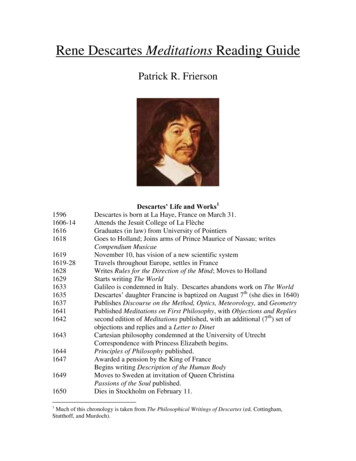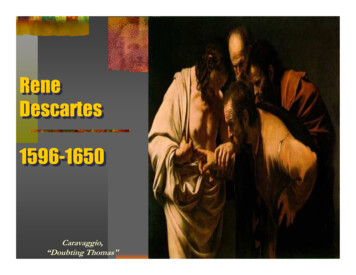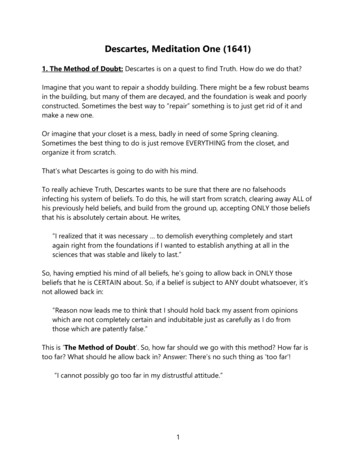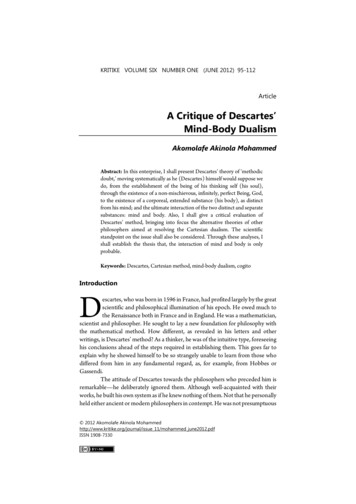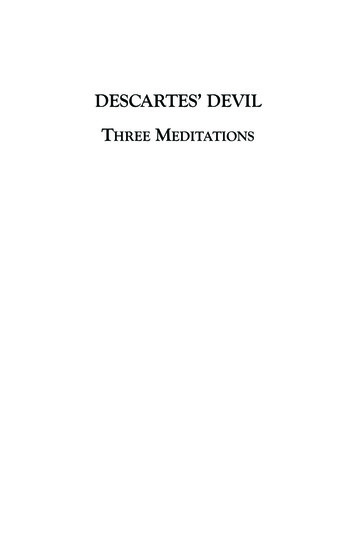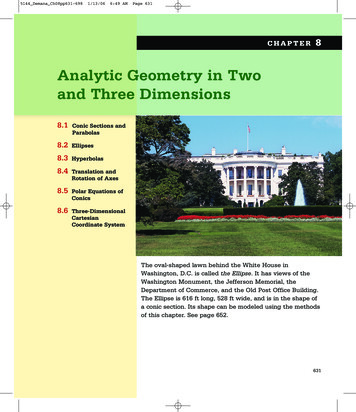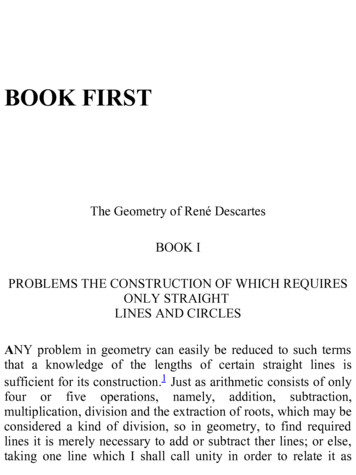
Transcription
BOOK FIRSTThe Geometry of René DescartesBOOK IPROBLEMS THE CONSTRUCTION OF WHICH REQUIRESONLY STRAIGHTLINES AND CIRCLESANY problem in geometry can easily be reduced to such termsthat a knowledge of the lengths of certain straight lines issufficient for its construction.1 Just as arithmetic consists of onlyfour or five operations, namely, addition, subtraction,multiplication, division and the extraction of roots, which may beconsidered a kind of division, so in geometry, to find requiredlines it is merely necessary to add or subtract ther lines; or else,taking one line which I shall call unity in order to relate it as
closely as possible to numbers,2 and which can in general bechosen arbitrarily, and having given two other lines, to find afourth line which shall be to one of the given lines as the other isto unity (which is the same as multiplication) ; or, again, to find afourth line which is to one of the given lines as unity is to theother (which is equivalent to division) ; or, finally, to find one,two, or several mean proportionals between unity and some otherline (which is the same as extracting the square root, cube root,etc., of the given line.3 And I shall not hesitate to introduce thesearithmetical terms into geometry, for the sake of greaterclearness.
For example, let AB be taken as unity, and let it be required tomultiply BD by BC. I have only to join the points A and C, anddraw DE parallel to CA ; then BE is the product of BD and BC.If it be required to divide BE by BD, I join E and D, and drawAC parallel to DE; then BC is the result of the division.If the square root of GH is desired, I add, along the samestraight line, FG equal to unity; then, bisecting FH at K, Idescribe the circle FIH about K as a center, and draw from G aperpendicular and extend it to I, and GI is the required root. I donot speak here of cube root, or other roots, since I shall speakmore conveniently of them later.Often it is not necessary thus to draw the lines on paper, but itis sufficient to designate each by a single letter. Thus, to add thelines BD and GH, I call one a and the other b, and write a b.Then a - b will indicate that b is subtracted from a; ab that a ismultiplied by b;that a is divided by b; aa or a2 that a ismultiplied by itself ; a3 that this result is multiplied by a, and soon, indefinitely.4 Again, if I wish to extract the square root ofa2 b2, I writeif I wish to extract the cube root of a3-b3 ab2, I writeand similarly for other roots.5Here it must be observed that by a2, b3, and similar expressions, Iordinarily mean only simple lines, which, however, I namesquares, cubes, etc., so that I may make use of the termsemployed in algebra.6It should also be noted that all parts of a single line shouldalways be expressed by the same number of dimensions,
provided unity is not determined by the conditions of theproblem. Thus, a3 contains as many dimensions as ab2 or b3,these being the component parts of the line which I have calledIt is not, however, the same thing when unityis determined, because unity can always be understood, evenwhere there are too many or too few dimensions; thus, if it berequired to extract the cube root of a2b2-b, we must consider thequantity a2b2 divided once by unity, and the quantity b multipliedtwice by unity.7Finally, so that we may be sure to remember the names ofthese lines, a separate list should always be made as often asnames are assigned or changed. For example, we may write,AB 1, that is AB is equal to 1;8 GH a, BD b, and so on.If, then, we wish to solve any problem, we first suppose thesolution already effected,9 and give names to all the lines thatseem needful for its construction,—to those that are unknown aswell as to those that are known.10 Then, making no distinctionbetween known and unknown lines, we must unravel thedifficulty in any way that shows most naturally the relationsbetween these lines, until we find it possible to express a singlequantity in two ways.11 This will constitute an equation, since theterms of one of these two expressions are together equal to theterms of the other.
We must find as many such equations as there are supposed tobe unknown lines;12 but if, after considering everything involved,so many cannot be found, it is evident that the question is notentirely determined. In such a case we may choose arbitrarilylines of known length for each unknown line to which therecorresponds no equation.13If there are several equations, we must use each in order, eitherconsidering it alone or comparing it with the others, so as toobtain a value for each of the unknown lines; and so we mustcombine them until there remains a single unknown line14 whichis equal to some known line, or whose square, cube, fourthpower, fifth power, sixth power, etc., is equal to the sum ordifference of two or more quantities,15 one of which is known,while the others consist of mean proportionals between unity andthis square, or cube, or fourth power, etc., multiplied by otherknown lines. I may express this as follows:z b,or z2 -az b2,or z3 az2 b2z-c3,or z4 az3-c3z d4, etc.That is, z, which I take for the unknown quantity, is equal to b;or, the square of z is equal to the square of b diminished by a
multiplied by z; or, the cube of z is equal to a multiplied by thesquare of z, plus the square of b multiplied by z, diminished bythe cube of c; and similarly for the others.Thus, all the unknown quantities can be expressed in terms of asingle quantity,16 whenever the problem can be constructed bymeans of circles and straight lines, or by conic sections, or evenby some other curve of degree not greater than the third orfourth.17But I shall not stop to explain this in more detail, because Ishould deprive you of the pleasure of mastering it yourself, aswell as of the advantage of training your mind by working overit, which is in my opinion the principal benefit to be derived fromthis science. Because, I find nothing here so difficult that itcannot be worked out by any one at all familiar with ordinarygeometry and with algebra, who will consider carefully all that isset forth in this treatise. 18
I shall therefore content myself with the statement that if thestudent, in solving these equations, does not fail to make use ofdivision wherever possible, he will surely reach the simplestterms to which the problem can be reduced.And if it can be solved by ordinary geometry, that is, by theuse of straight lines and circles traced on a plane surface,19 whenthe last equation shall have been entirely solved there will remainat most only the square of .an unknown quantity, equal to theproduct of its root by some known quantity, increased ordiminished by some other quantity also known.20 Then this rootor unknown line can easily be found. For example, if I havez2 az b2,21 I construct a right triangle NLM with one side LM,equal to b, the square root of the known quantity b2, and the otherside, LN, equal tothat is, to half the other known quantitywhich was multiplied by z, which I supposed to be the unknownline. Then prolonging MN, the hypotenuse22 of this triangle, toO, so that NO is equal to NL, the whole line OM is the requiredline z. This is expressed in the following way:23But if I have y2 ay b2, where y is the quantity whose valueis desired, I construct the same right triangle NLM, and on thehypotenuse MN lay off NP equal to NL, and the remainder PM is
y, the desired root. Thus I haveIn the same way, if I hadx4 ax2 b2,PW wouid be x2 and I should haveand so for other cases.Finally, if I have z2 az b2, I make NL equal toand LMequal to b as before; then, instead of joining the points M and N, Idraw MQR parallel to LN, and with N as a center describe acircle through L cutting MQR in the points Q and R; then z, theline sought, is either MQ or MR, for in this case it can be
expressed-in two ways, namely:24and
And if the circle described about N and passing through Lneither cuts nor touches the line MQR, the equation has no root,so that we may say that the construction of the problem isimpossible.These same roots can be found by many other methods, 25 Ihave given these very simple ones to show that it is possible toconstruct all the problems of ordinary geometry by doing nomore than the little covered in the four figures that I haveexplained.26 This is one thing which I believe the ancientmathematicians did not observe, for otherwise they would nothave put so much labor into writing so many books in which thevery sequence of the propositions shows that they did not have asure method of finding all,27 but rather gathered together thosepropositions on which they had happened by accident.This is also evident from what Pappus has done in thebeginning of his seventh book,28 where, after devotingconsiderable space to an enumeration of the books on geometrywritten by his predecessors,29 he finally refers to a questionwhich he says that neither Euclid nor Apollonius nor any one elsehad been able to solve completely; 30 and these are his words:“Quem autem dicit (Apollonius) in tertio libro locum ad& quatuor lineas ab Euclide perfectuvn non esse, nequeperficere poterat, neque aliquis alius; sed neque paululumaddere iis, quœ Eveclides scripsit, per ea tantum conica,usque ad Euclidis tempora prcemonstrata sunt, &c.” 31tres,ipsequidquœA little farther on, he states the question as follows:“At locus ad tres, & quatuor lineas, in quo (Apollonius)
magnifice se jactat, & ostentat, nulla habita gratia ei, qui priusscripserat, est hujusmodi. 32 Si positione datis tribus rectis lineisab uno & eodem puncto, ad tres lineas in datis angulis rectoelinece ducantur, & data sit proportion rectanguli contenti duabusductis ad quadratum reliquœ: punctum eontingit positione datumsolidum locum, hoc est unam ex tribus conicis sectioltzbus. Et siad quatuor rectas lineas positione datas in datis angulis lineceducantur; & rectanguli duabus ductis contenti ad contentumduabus reliquis proportio data sit; similiter punctum datum conisectionem positione continget. Si quidem igitur ad duas tantumlocus planus ostensus est. Quod si ad lures quam quatuor,punctum continget locos non adhuc cognitos, sed lineas tantumdictas; quales autem sint, vel quam habeant proprietatem, nonconstat: earum unam, neque primam, & quce manifestissimavidetur, composuerunt ostendentes utilem esse. Propositionesautem ipsarum hce sunt.“Si ab aliquo puncto ad positione datas rectas lineas quinqueducantur rectce linece in datis angulis, & data sit proportiosolidi parallelepipedi rectanguli, quod tribus ductis lineiscontinetur ad solidum parallelepipedum rectangulum, quodcontinetur reliquis duabus, & data quapiam linea, punctumpositione datam lineam continget. Si autem ad sex, & data sitproportion solidi tribus lineis contenti ad solidum, quod tribusreliquis contisaetur; rursus punctum continget positions datamlineam. Quod si ad plures quam sex, non adhuc habent diccre, andata sit proportio cujuspiam contenti quatuor lineis ad id quodreliquis continetur, quoniam non est aliquid contentum pluribusquam tribus dimensionibus.” 33
Here I beg you to observe in passing that the considerationsthat forced ancient writers to use arithmetical terms in geometry,thus making it impossible for them to proceed beyond a pointwhere they could see clearly the relation between the twosubjects, caused much obscurity and embarrassment, in theirattempts at explanation.Pappus proceeds as follows:“Acquiescunt autem his, qui paulo ante talia interpretati sunt;neque unum aliquo pacto comprehensibile significantes quod hiscontinetur. Licebit autem per conjunctas proportiones hœc, &dicere & demonstrare universe in dictis proportionibus, atque hisin hunc modum. Si ab aliquo puncto ad positione datas rectaslineas ducantur rectœ lineœ in datis angulis, & data sit proportioconjuncta ex ea, quam habet una ductarum ad unam, & altera adalteram, & alia ad aliam, & reliqua ad datam lineam, si sintseptcm; si vero octo, & reliqua ad reliquam: punctum contingetpositione datas lineas. Et similiter quotcumque sint impares velpares multitudine, cum hœc, ut dixi, loco ad quatuor lincasrespondeant, nullum igitur posuerunt ita ut linea nota sit, &c.34The question, then, the solution of which was begun by Euclidand carried farther by Apollonius, but was completed by no one,is this:Having three, four or more lines given in position, it is firstrequired to find a point from which as many other lines may bedrawn, each making a given angle with one of the given lines, sothat the rectangle of two of the lines so drawn shall bear a givenratio to the square of the third (if there be only three) ; or to therectangle of the other two (if there be four), or again, that the
parallelepiped35 constructed upon three shall bear a given ratio tothat upon the other two and any given line (if there be five), or tothe parallelepiped upon the other three (if there be six) ; or (ifthere be seven) that the product obtained by multiplying four ofthem together shall bear a given ratio to the product of the otherthree, or (if there be eight) that the product of four of them shallbear a given ratio to the product of the other four. Thus thequestion admits of extension to any number of lines.Then, since there is always an infinite number of differentpoints satisfying these requirements, it is also required todiscover and trace the curve containing all such points.36 Pappussays that when there are only three or four lines given, this line isone of the three conic sections, but he does not undertake todetermine, describe, or explain the nature of the line required37when the question involves a greater number of lines. He onlyadds that the ancients recognized one of them which they hadshown to be useful, and which seemed the simplest, and yet wasnot the most important.38 This led me to try to find out whether,by my own method, I could go as far as they had gone.39
First, I discovered that if the question be proposed for onlythree, four, or five lines, the required points can be found byelementary geometry, that is, by the use of the ruler andcompasses only, and the application of those principles that Ihave already explained, except in the case of five parallel lines.In this case, and in the cases where there are six, seven, eight, ornine given lines, the required points can always be found bymeans of the geometry of solid loci,40 that is, by using some oneof the three conic sections. Here, again, there is an exception inthe case of nine parallel lines. For this and the cases of ten,eleven, twelve, or thirteen given lines, the required points may befound by means of a curve of degree next higher than that of theconic sections. Again, the case of thirteen parallel lines must beexcluded, for which, as well as for the cases of fourteen, fifteen,sixteen, and seventeen lines, a curve of degree next higher thanthe preceding must be used; and so on indefinitely.Next, I have found that when only three or four lines are given,the required points lie not only all on one of the conic sectionsbut sometimes on the circumference of a circle or even on astraight line.41When there are five, six, seven, or eight lines, the requiredpoints lie on a curve of degree next higher than the conicsections, and it is impossible to imagine such a curve that maynot satisfy the conditions of the problem; but the required pointsmay possibly lie on a conic section, a circle, or a straight line. Ifthere are nine, ten, eleven, or twelve lines, the required curve isonly one degree higher than the preceding, but any such curvemay meet the requirements, and so on to infinity.Finally, the first and simplest curve after the conic sections is
the one generated by the intersection of a parabola with a straightline in a way to be described presently.I believe that I have in this way completely accomplished whatPappus tells us the ancients sought to do, and I will try to give thedemonstration in a few words, for I am already wearied by somuch writing.Let AB, AD, EF, GH, . be any number of straight lines givenin position,42 and let it be required to find a point C, from whichstraight lines CB, CD, CF, CH, . can be drawn, making givenangles CBA, CDA, CFE, CHG, . respectively, with the givenlines, and such that the product of certain of them is equal to theproduct of the rest, or at least such that these two products shallhave a given ratio, for this condition does not make the problemany more difficult.
First, I suppose the thing done, and since so many lines areconfusing, I may simplify matters by considering one of thegiven lines and one of those to be drawn (as, for example, ABand BC) as the principal lines, to which I shall try to refer all theothers. Call the segment of the line AB between A and B, x, andcall BC, y. Produce all the other given lines to meet these two(also produced if necessary) provided none is parallel to either ofthe principal lines. Thus, in the figure, the given lines cut AB inthe points A, E, G, and cut BC in the points R, S, T.Now, since all the angles of the triangle ARB are known,43 theratio between the sides AB and BR is known.44 If we let AB : BR z : b, since AB x, we havebetween C and R45,we havebetween C and B, CR is equal toand since B lies(When R liesand when C liesbetween B and R, CR is equal to) Again, the three46angles of the triangle DRC are known, and therefore the ratiobetween the sides CR and CD is determined. Calling this ratio z :c, sincewe haveThen,since the lines AB, AD, and EF are given in position, the distancefrom A to E is known. If we call this distance k, then EB k x;although EB k - x when B lies between E and A, and E -k xwhen E lies between A and B. Now the angles of the triangle
ESB being given, the ratio of BE to BS is known. We may callthisratioz:d.47ThenandWhen S lies between B and C we haveand when C lies between B and S wehaveThe angles of the triangle FSCare known, and hence, also the ratio of CS to CF, or z : e.Therefore,Likewise, AG or l isgiven, and BG l - x. Also, in triangle BGT, the ratio of BG toBT, or z : f, is known. Therefore,andIn triangle TCH, the ratio of TC to CH,or z : g, is known,48 whence
And thus you see that, no matter how many lines are given inposition, the length of any such line through C making givenangles with these lines can always be expressed by three terms,one of which consists of the unknown quantity y multiplied ordivided by some known quantity; another consisting of theunknown quantity x multiplied or divided by some other knownquantity; and the third consisting of a known quantity.49 Anexception must be made in the case where the given lines areparallel either to AB (when the term containing x vanishes), or toCB (when the term containing y vanishes). This case is toosimple to require further explanation.50 The signs of the termsmay be either or - in every conceivable combination.51You also see that in the product of any number of these linesthe degree of any term containing x or y will not be greater thanthe number of lines (expressed by means of x and y) whoseproduct is found. Thus, no term will be of degree higher than thesecond if two lines be multiplied together, nor of degree higherthan the third, if there be three lines, and so on to infinity.Furthermore, to determine the point C, but one condition isneeded, namely, that the product of a certain number of linesshall be equal to, or (what is quite as simple), shall bear a givenratio to the product of certain other lines. Since this condition canbe expressed by a single equation in two unknown quantities,52we may give any value we please to either x or y and find thevalue of the other from this equation. It is obvious that when notmore than five lines are given, the quantity x, which is not used toexpress the first of the lines can never be of degree higher thanthe second.53
Assigning a value to y, we have x2 ax b2, and therefore xcan be found with ruler and compasses, by a method alreadyexplained.54 If then we should take successively an infinitenumber of different values for the line y, we should obtain aninfinite number of values for the line x, and therefore an infinityof different points, such as C, by means of which the requiredcurve could be drawn.This method can be used when the problem concerns six ormore lines, if some of them are parallel to either AB or BC, inwhich case either x or y will be of only the second degree in theequation, so that the point C can be found with ruler andcompasses.
On the other hand, if the given lines are all parallel eventhough a question should be proposed involving only five lines,the point C cannot be found in this way. For, since the quantity xdoes not occur at all in the equation, it is no longer allowable togive a known value to y. It is then necessary to find the value ofy.55 And since the term in y will now be of the third degree, itsvalue can be found only by finding the root of a cubic equation,which cannot in general be done without the use of one of theconic sections.56And furthermore, if not more than nine lines are given, not allof them being parallel, the equation can always be so expressedas to be of degree not higher than the fourth. Such equations canalways be solved by means of the conic sections in a way that Ishall presently explain.57Again, if there are not more than thirteen lines, an equation ofdegree not higher than the sixth can be employed, which admitsof solution by means of a curve just one degree higher than theconic sections by a method to be explained presently.58This completes the first part of what I have to demonstratehere, but it is necessary, before passing to the second part, tomake some general statements concerning the nature of curvedlines.
1 Large collections of problems of this nature are contained inthe following works: Vincenzo Riccati and Girolamo Saladino,Iustitutiones Analyticae, Bologna, 1765; Maria Gaetana Agnesi,Istituaioni Analitiche, Milan. 1748; Claude Rabuel,Conznsentaires sur la Géométrie de M. Descartes, Lyons, 1730(hereafter referred to as Rabuel) ; and other books of the sameperiod or earlier.2 Van Schooten, in his Latin edition of 1683, has this note: “Perunitatem intellige lineam quandam determinatam, qua adquamvis reliquarum linearum talem relationem habeat, qualemunitas ad certum aliquem numerum.” Geometria a Reszato DesCartes, una cum notis Florisnondi de Beaune, opera atque studioFrancisci à Schooten, Amsterdam, 1683, p. 165 (hereafterreferred to as Van Schooten). ,In general, the translation runs page for page with thefacing original. On account of figures and footnotes,however, this plan is occasionally varied, but not in such away as to cause the reader any serious inconvenience.3 While in arithmetic the only exact roots obtainable are thoseof perfect powers, in geometry a length can be found which willrepresent exactly the square root of a given line, even though thisline be not commensurable with unity. Of other roots, Descartesspeaks later.4 Descartes uses a3, a4, a5, a6, and so on. to represent therespective powers of a, but he uses both aa and a2 withoutdistinction. For example, he often has aabb, but he also uses
5 Descartes writes:line 9.See original, page 299,6 At the time this was written, a2 was commonly considered tomean the surface of a square whose side is a, and b3 to mean thevolume of a cube whose side is b; while b4, b5, . wereunintelligible as geometric forms. Descartes here says that a2does not have this meaning, but means the line obtained byconstructing a third proportional to 1 and a, and so on.7 Descartes seems to say that each term must be of the thirddegree, and that therefore we must conceive of both a2b2 and b asreduced to the proper dimension.8Van Schooten adds “seu unitati,” p. 3. Descartes writes,He seems to have been the first to use this symbol.Among the few writers who followed him, was Hudde (16331704). It is very commonly supposed thatis a ligaturerepresenting the first two letters (or diphthong) of “aequare.” See,for example, M. Aubry’s note in W. W. R. Ball’s RecréationsMathématiques et Problèmes des Temps Anciens et Modernes,French edition, Paris, 1909, Part III, p. 164.9 This plan, as is well known, goes back to Plato. It appears inthe work of Pappus as follows: “In analysis we suppose thatwhich is required to be already obtained, and consider itsconnections and antecedents, going back until we reach eithersomething already known (given in the hypothesis), or else somefundamental principle (axiom or postulate) of mathematics.”Pappi Alexandrini Collectiones quac supcrsunt c libris manu
scripts edulit Latina interpellatione et commentariis instruxitFredericus Hultsch, Berlin, 1876-1878; vol. II, p. 635 (hereafterreferred to as Pappus). See also Commandinus, PappiAlexandrini Mnthemnticae Collectiones, Bologna, 1588, withlater editions.Pappus of Alexandria was a Greek mathematician wholived about 300 A.D. His most important work is amathematical treatise in eight books, of which the first andpart of the second are lost. This was made known to modernscholars by Commandinus. The work exerted a happyinfluence on the revival of geometry in the seventeenthcentury. Pappus was not himself a mathematician of the firstrank, but he preserved for the world many extracts oranalyses of lost works, and by his commentaries added totheir interest.10 Rabuel, calls attention to the use of a, b, c, . for known, andx, y, z, . for unknown quantities (p. 20).11 That is, we must solve the resulting simultaneous equations.12 Van Schooten (p. 149) gives two problems to illustrate thisstatement. Of these, the first is as follows: Given a line segmentAB containing any point C, required to produce AB to D so thatthe rectangle AD.DB shall be equal to the square on CD. He letsAC a, CB b, and BD x. Then AD a b x, and CD b x,whence ax bx x2 b2 2bx x2 and13Rabuel adds this note : “We may say that everyindeterminate problem is an infinity of determinate problems, or
that every problem is determined either by itself or by him whoconstructs it” (p. 21).14 That is, a line represented by x, x2, x3, x4, .15 In the older French, “le quarré. ou le cube, ou lie quarré dequarré, ou le sursolide, ou le quarré de cube &c.,” as seen onpage 11 (original page 302).16 See line 20 on the opposite page.17 Literally, “Only one or two degrees greater.”18 In the Introduction to the 1637 edition of La Géométrie,Descartes made the following remark: “In my previous writings Ihave tried to make my meaning clear to everybody; but I doubt ifthis treatise will be read by anyone not familiar with the books ongeometry, and so I have thought it superfluous to repeatdemonstrations contained in them.” See Oeuvres de Descartes,edited by Charles Adam and Paul Tannery, Paris, 1897-1910, vol.VI, p. 368. In a letter written to Mersenne in 1637 Descartes says:“I do not enjoy speaking in praise of myself, but since few peoplecan understand my geometry, and since you wish me to give youmy opinion of it, I think it well to say that it is all I could hopefor, and that in La Dioptrique and Les Météores, I have.only triedto persuade people that my method is better than the ordinaryone. I have proved this in my geometry, for in the beginning Ihave solved a question which, according to Pappus, could not besolved by any of the ancient geometers.“Moreover, what I have given in the second book on thenature and properties of curved lines, and the method of
examining them, is, it seems to me, as far beyond thetreatment in the ordinary geometry, as the rhetoric of Cicerois beyond the a, b, c of children.“As to the suggestion that what I have written could easilyhave been gotten from Vieta, the very fact that my treatise ishard to understand is due to my attempt to put nothing in itthat I believed to be known either by him or by any oneelse. I begin the rules of my algebra with what Vieta wroteat the very end of his book, De owetadationeaequationum. Thus, I begin where he left off.” Oeuvres deDescortes, publiécs par Victor Cousin, Paris, 1824, Vol. VI,p. 294 (hereafter referred to as Cousin).In another letter to Mersenne, written April 20, 1646,Descartes writes as follows: “I have omitted a number ofthings that might have made it (the geometry) clearer, but Idid this intentionally, and would not have it otherwise. Theonly suggestions that have been made concerning changes init are in regard to rendering it clearer to readers, but most ofthese are so malicious that I am completely disgusted withthem.” Cousin, Vol. IX, p. 553.In a letter to the Princess Elizabeth, Descartes says: “Inthe solution of a geometrical problem I take care, as far aspossible, to use as lines of reference parallel lines or lines atright angles; and I use no theorems except those whichassert that the sides of similar triangles are proportional, andthat m a right triangle the square of the hypotenuse is equalto the sum of the squares of the sides. I do not hesitate tointroduce several unknown quantities, so as to reduce thequestion to such terms that it shall depend only on these twotheorems.” Cousin, Vol. IX, p. 143.
19 For a discussion of the possibility of constructions by thecompasses and straight edge, see Jacob Steiner, Dieyeometrischen Constructionen ausgeführt mittelst der geradenLinie und eines festen Kreises, Berlin, 1833. For briefertreatments, consult Enriques, Fragen der Elementor-Geometrie,Leipzig, 1907; Klein, Problems. in Elementary Gcometry, trans.by Beman and Smith, Boston, 1897; Weber und Wellstein,Eitcyklopädic der Elensentaren Geometrie, Leipzig, 1907. Thework by Mascheroni, La geometria del compasso, Pavia, 1797, isinteresting and well known.20 That is, an expression of the form z2 as b. “Esgal a ce quise produit de 1’Addition, ou soustraction de sa racine multipléepar quelque quantité connue, & de quelque autre quantité aussycon
The Geometry of René Descartes BOOK I PROBLEMS THE CONSTRUCTION OF WHICH REQUIRES ONLY STRAIGHT LINES AND CIRCLES ANY problem in geometry can easily be reduced to such terms that a knowledge of the lengths of certain straight lines is sufficient for its construction.1 Just as arithmetic consists of only

